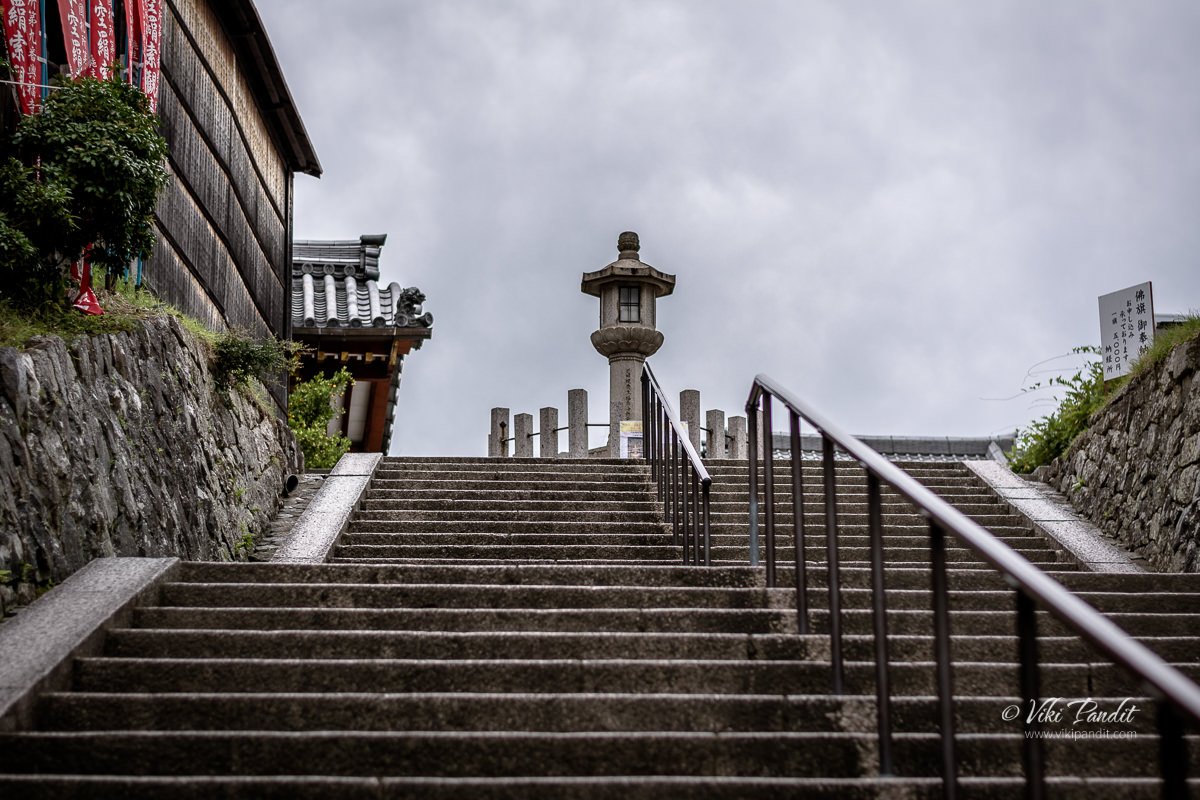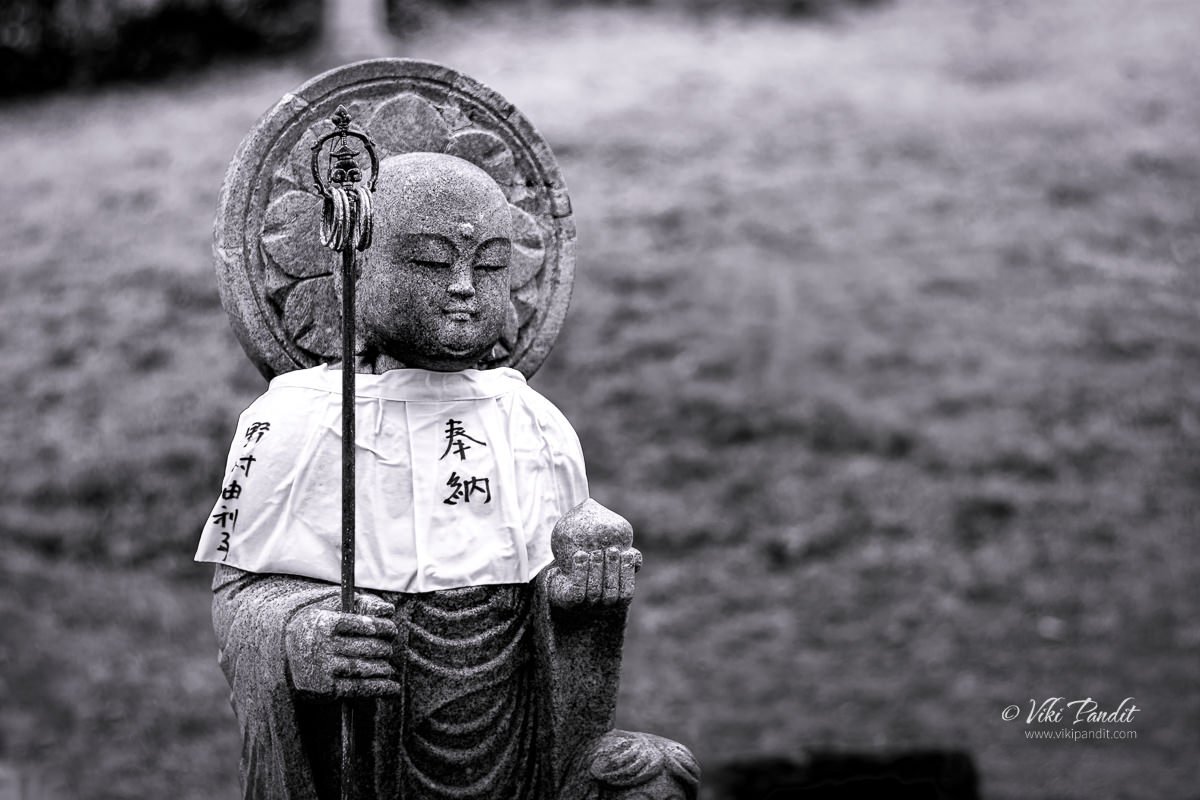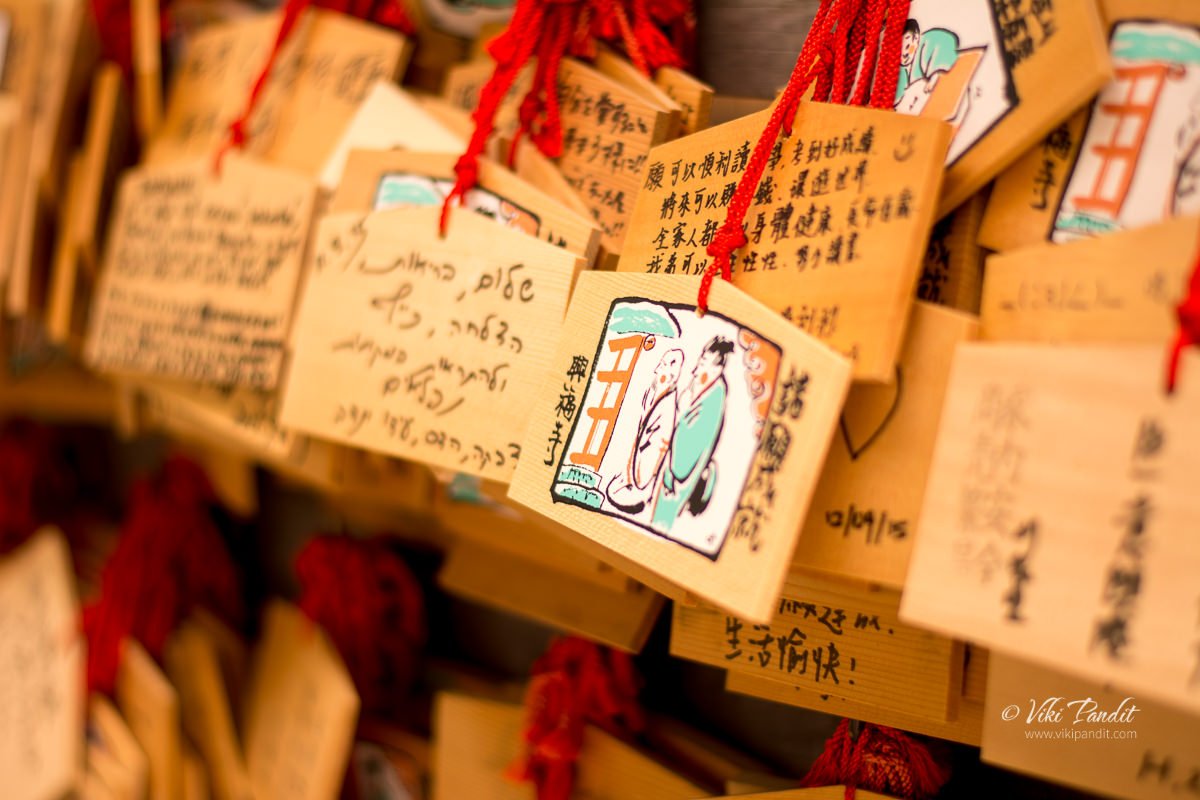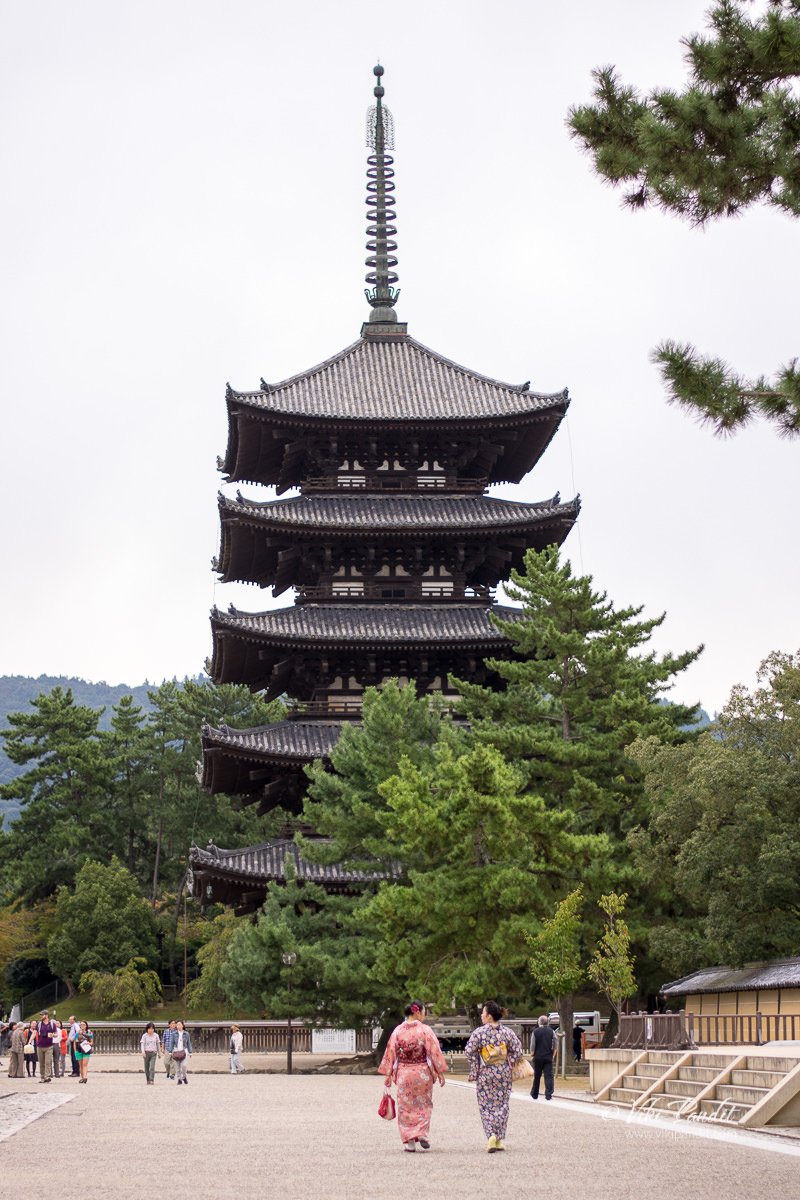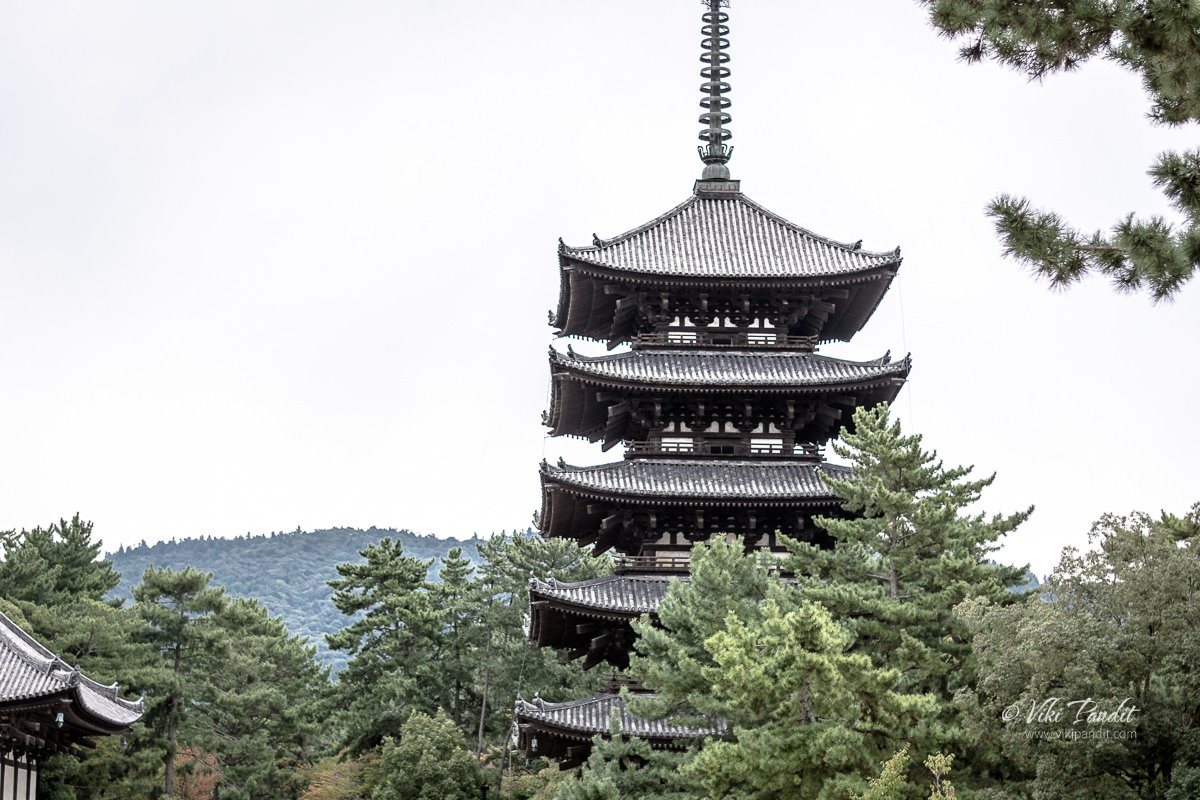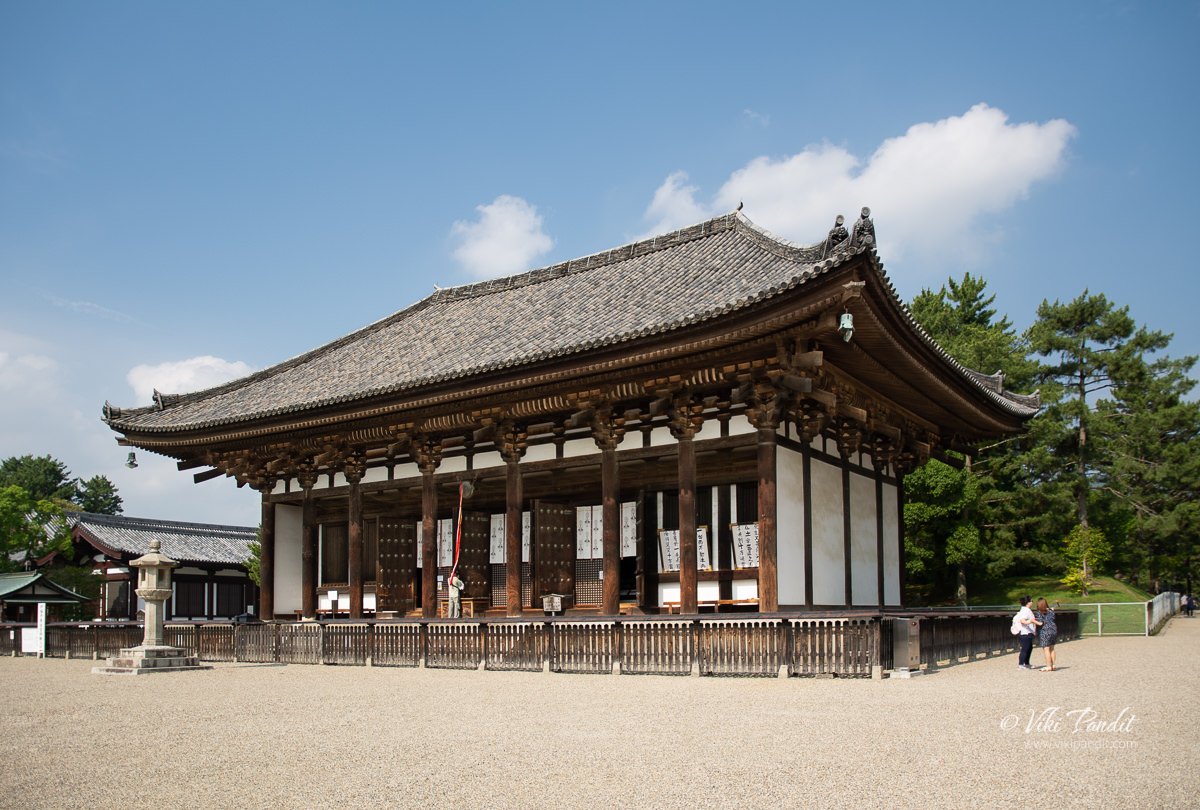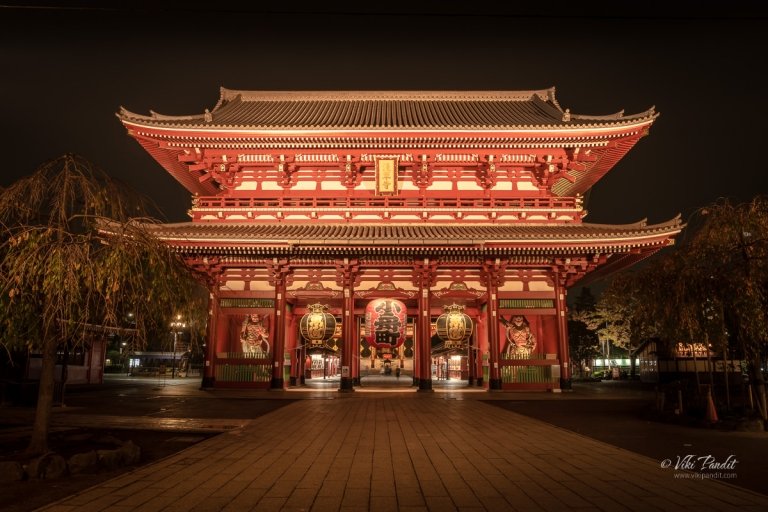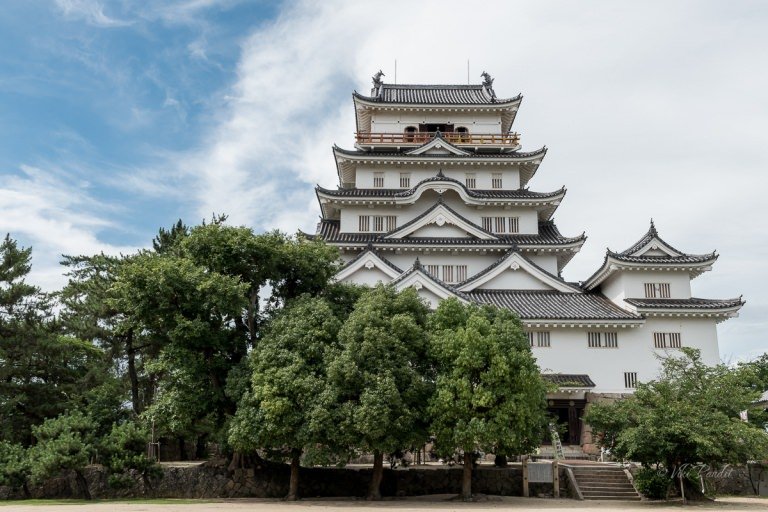Kofuku-ji is both a landmark and a symbol of Nara. It used to be the family temple of the Fujiwara, the most powerful family clan during much of the Nara and Heian Periods. The temple originally is said to have contained almost 150 buildings in its premises, but only a few have survived, and most rebuilt over the years.
I had a quick breakfast at the Nara University cafeteria and head off to Kofuku-ji on foot using the narrow lanes. The route I love to go to Kofuku-ji is via the Sanjo-dori. It is the happening street in the area with hundreds of shops selling souvenirs and local delicacies. There is always a buzz along the street and I love to visit it often, just to have a good time.
A brief history of Kofuku-ji
Today Kofuku-ji is one of the head temples of the Hosso sect of Buddhism but it has had a very humble beginning. In the year 669 CE, Kagami no Okimi, the consort of Nakatomi-no-Kamatari, founded a Buddhist temple on their family estate in Yamashina Suehara (modern-day Kyoto) to pray for her husband’s recovery from illness.
Her literary works appear in Manyoshu, the oldest extant collection of Japanese waka (poetry in Classical Japanese), compiled sometime after AD 759 during the Nara period. In “Manyoshu,” her name appears as ‘鏡王女’ while in “Nihonshoki” (Chronicles of Japan) it is ‘鏡姫王.’ Her poems are said to be composed after Kamatari’s death, in the memory of her husband. She is also widely considered to be the birth mother of FUJIWARA no Fuhito, who later went on to be the founding patron of Kofuku-ji.
This temple which came to be known as Yamashina-dera was relocated to its present site shortly after the establishment of Heijo as the capital of the empire. The temple was renamed to Kofuku-ji and it grew rapidly in size under the patronage of successive emperor and empresses. During that time the Fujiwara clan had great influence over the imperial family and their blessings to Kofuku-ji, propelled its rise to an important influence even in political matters. In the Heian period (794-1180), the temple assumed control over the Fujiwara tutelary shrine of Kasuga and rose to become the dominant power in Yamato province.
Over time with the decline of the Fujiwara clan, the temple lost its shine. The temple was destroyed by the Taira, rivals of the Fujiwara, in the 12th century Heike wars. Financial pressures eroded the political influence that it had previously enjoyed. In 1595, during the reign of Toyotomi Hideyoshi, the temple was stripped of its last remaining estates and replaced them with an annual endowment of only 21,000 koku of rice. Although this amount was sufficient for the maintenance of the temple grounds, a catastrophic fire in 1717 destroyed most of the temple complexes.
With waning power, Kofuku-ji became one of the primary targets of the anti-Buddhist policies of the early years of the Meiji period (1868-1912). In 1868, the Japanese government brought out an ordinance called shinbutsu bunri, which ordered the separation of Shinto from Buddhism. This brought to an abrupt end the centuries-old tie between Kasuga and Kofuku-ji. After a few years when things calmed down, Kofuku-ji was granted permission to re-establish itself as a religious institution.
As you keep walking along the Sanjo-dori. the road will open up near a pond, that falls on the right. it is the Surosawa pond. On your left, you will find a stone staircase that will take you inside the Kofuku-ji grounds. These stairs always remind me of the end scene from the movie “Your Name.”
As I went up the stone stairs, midway to the top, there is a left path, where you can find a Jizo statue surrounded by idols of little children. I spent some time here with the Jizo. The idol is carved out of a single piece of stone. It reminded me of the stone idols from our Hampi trip. The Sun was soft and I was able to get some nice sharp images.
The Jizo referred to as “O-Jizo-san” in Japanese honorific language, is a deity fondly loved by Japanese people. You will find Jizo statues like this in many places including Buddhist temples, graveyards, beside lakes, and even at the corner of some streets in the cities. If you are interested in exploring more, you should visit the Hase-dera temple in Kamakura which is said to host, on its grounds thousands of Jizo statues.
During colder times, you will find them draped in red. Jizo statues are clothed in red bibs and sometimes also hoods. What is a bit funny for me is that, you might also sometimes find cans of Sake beside the statues. The Japanese mostly pray to the Jizo wishing for protection for their lost baby so their spirits might go to heaven without suffering.
Three Storeyed Pagoda
Just beyond the Jizo statue there lies a three-story pagoda. This Pagoda was originally built in 1143 CE at the behest of Fujiwara no Kiyoko, the consort of Emperor Sutoku. The current pagoda was recreated shortly after the destruction of the entire temple complex in 1811, making it one of the oldest of the structures at Kofukuji.
The first storey contains a set of four murals painted on wooden panels that each depicts a Buddha. In addition, the goddess Benzaiten (Saraswati) is enshrined on the eastern face of the central pillar.
After taking some shots of the pagoda, I retraced my steps back to the staircase. As you reach the top you will find yourself in front of the Nanendo hall or commonly referred to as the Southern Hall. Before you go for the hall, if you check on your right, you will find a Chuyoza, a place to purify yourself before you go to pray at the temple.
It’s not much of a deal, you just take the ladle, fill it with the running water and wash your hands one at a time. In the end, you let the remaining water drip down along the handle of the ladle where you were holding it, in a way cleansing it for the next person to use.
The Southern Hall
The southern octagonal hall was initially built in 813 by Fujiwara no Fuyutsugu, in memory of his father. The current hall is the fourth reconstruction and was erected between 1741 and 1789. Enshrined inside it is a seated image of Fukukensaku Kannon.
The southern hall is opened to the public only one day in the year on October 17th
Some people were praying in front of the Nanen-do hall. The air was smoky with the incense sticks burning on an urn placed in front of the temple. Beside the temple hall, there is a small shop that sells incense sticks for ¥100. You can choose between sticks for praying for either health, happiness, or wealth. The words are written in Japanese only, so you might need someone to assist you if you are not able to understand which one to choose.
A left turn here will take you to the Hokuen-do. It was built in 721 by the Empress Gemmei and Emperor Gensho to commemorate the first death anniversary of Fujiwara Fuhito. The building originally dates back over a thousand years, and their present reconstructions were completed in 1210 respectively. The building also houses some of the temple’s treasured artifacts but is only open to the public only a few days a year. Notably among them is a set of four images of the heavenly kings that were created in 791, the finest examples of Japanese dry-lacquer sculptures.
The building is open to the public only on special days every year. The dates of this period vary every year, so please contact the temple authorities before visiting.
A few steps ahead there is a flat base, where once Kofukuji’s main building, the Central Golden Hall used to stand. It was destroyed in a fire in 1717 and – although a replacement hall was built on a smaller scale in the 1800’s – the original Central Golden Hall was not reconstructed. Reconstruction works are currently ongoing and are scheduled to be completed in the year 2018.
The Central Golden Hall opened in 2018, I have updated the details at the end of the journal.
For me, Kofuku-ji’s main attraction is the five-story pagoda known as Gojunoto. At 50.1 meters, it is the second tallest pagoda in Japan after Kyoto’s Toji Temple. The construction of the Five-storied Pagoda was originally started in 730 by Empress Komyo, the daughter of Kofukuji’s founding patron: Fujiwara no Fuhito.
Over its long history, the pagoda burned down a total of five times, with the latest reconstruction dating to around 1426. Enshrined around its central pillar, on the first story are a Yakushi triad (East), a Shaka triad (South) and an Amida triad (West) and a Miroku triad (North)
Lots of women visiting the temple were in the traditional Kimono. It was a beautiful sight to see them walking past the ancient temple. If you are interested in obtaining a Kimono for rental, there are many places along Sanjo-dori, but you have to book it in advance.
Eastern Golden Hall
Beside the Gojunoto is the Easter Golden Hall. The Eastern Golden Hall (Tokondo) was originally constructed in 726 by Emperor Shomu to speed the recovery of the ailing Empress Gensho. Rebuilt in 1415, the Tokondo hall is dominated by the presence of a large image of Yakushi Nyorai (the Healing Buddha) along with the Bodhisattava Nikko & Gakko. The hall also features seated images of 12th-century wooden Monju Bosatsu and Yuima Koji, surrounded by standing images of Four Heavenly Kings.
National Treasure Hall
The Kofuku-ji National Treasure Hall (Kokuhokan) was erected in 1959 to house images, paintings, ritual artifacts, and historical documents that were enshrined in temple buildings that no longer exist. Among the most notable treasures are an 8th-century statue of Ashura (one of Buddha’s eight protectors) carved in the 8th century, an even older bronze head of Yakushi Nyorai, and 12th-century carved wooden statues of priests with strikingly human facial features.
While entrance to Kofukuji’s temple grounds is free and possible around the clock, there are two areas that require paying an entrance fee: Kofukuji’s National Treasure Museum and the Eastern Golden Hall. The recently renovated National Treasure Museum exhibits part of the temple’s great art collection and is an absolute must-see for lovers of Buddhist art. Among the many outstanding exhibits is the three-faced, six-armed Asura Statue, one of the most celebrated Buddhist statues in all of Japan. Unfortunately for me, it was closed on the day.
Kofuku-ji is a nice place to enjoy the history of Nara. Besides the temple, there are many other things to enjoy in Nara Park. If you are the explorer type, you should also check out Umikodo Pavilion, when looks stunning at night.
Kofuku-ji in Fall
Since I lived nearby, I came to Kofuku-ji many times. This is a shot of the beautiful pagoda during the fall. Nara Park has a brilliant fall and if possible, you should plan a trip at that time. For more information you can check out my journal of Nara during Fall.
Update: Central Golden Hall
The Central Golden Hall was opened to visitors in October 2018. Initially, the hall was constructed between 710 and 714 at the behest of Fujiwara-no-Fuhito. It has had an unfortunate history, with the building burned down a total of 7 times. The most recent of these fires occurred in 1717. With dwindling finances, more than a century passed before a temporary structure was finally erected in 1819.
However, the hall suffered extensive damage due to a leaking roof and had to be demolished in 2000. The newly constructed hall faithfully reproduces the Nara-period original based on archaeological evidence, drawings, and other historical records.
We came back at night to capture the celebration of the opening of this grand hall. At the time of writing this, visitors are not allowed to photograph the inside of the hall.
Later that night, we had a quiet stroll along Surosawa pond. The atmosphere becomes quite calm once the day tourists go back to Kyoto and you can enjoy some quiet time by yourself near the pond. I have spent many evenings here, just sitting and staring at the surroundings. A vending machine nearby will fulfill most of your needs if you are thirsty.
Kofuku-ji is one of the first temples I visited when I came to Japan and it will always have a special place in my memories. If and when you are visiting do not forget to explore Nara Park, it is huge and you will never forget the experience of the deer moving around among humans as you could only imagine in fantasy stories.
Thanks you so much for reading. I hope you have a wonderful time experiencing Nara as I did. Please leave me a comment if you liked my story or if you need to ask anything. I am also available on Instagram if you want to connect. Peace.
Adults: ¥500
School Students: ¥300
Adults: ¥700
School Students: ¥600
Adults: ¥300
School Students: ¥200
Kufuku-ji had a very humble beginning and the first structure was built in 669 CE in old Kyoto. It was later moved to Nara and succeeding generations of the Fujiwara clan kept building on it until it became a massive temple grounds comprising of over 140 buildings.
The first structure of the Kofuku-ji temple was commissioned by Kagami no Okimi, the legal wife of FUJIWARA no Kamatari. To pray for the recovery of Kamatari’s illness, she established Yamashina-dera Temple in 669 CE, which later became Kofuku-ji Temple.
Disclaimer: The information presented in this article is based on the time I visited the premises. Note that there might be changes in the prices of merchandise and admission fees that might have occurred after this article was published. At times the facility might also be closed for repairs or for variety of other reasons. Kindly contact the facility or facilities mentioned in this article directly before visiting.
Usage of this site indicates acceptance of my Terms and Conditions.
Credits: The historical information presented herein is gathered mostly from local guides that were re-inforced via historical writings.

